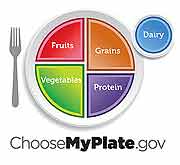
THURSDAY, June 2 (HealthDay News) — In its latest effort to get Americans to eat healthier meals and fight the obesity epidemic, the federal government has introduced a new nutrition icon called MyPlate.
MyPlate replaces the U.S. Department of Agriculture’s Food Pyramid, which was unveiled in 1992 but had become too complicated in ensuing years, many nutritionists contended.
“We are going to continue to have conversations about balanced meals to make this seem fun and simple and not complicated and overburdened,” First Lady Michelle Obama said during a Thursday morning press briefing to introduce the MyPlate icon.
“We can do something that makes a difference, something that people can use in their everyday lives,” added Obama, who has made combating obesity a priority since becoming First Lady.
The MyPlate logo suggests people eat balanced meals consisting of servings of fruits, vegetables, grains, protein and a small amount of dairy. To help make healthy choices, the USDA is also introducing a website called ChooseMyPlate.gov.
The site is designed to provide consumers with practical information on healthful eating. For example, MyPlate recommends reducing portion size; making at least half of each meal fruits and vegetables; making at least half of grains consumed whole grains, such as whole wheat bread and pasta; and switching to fat-free or low-fat (1 percent) milk.
In addition, the program urges cutting down on salt consumption and drinking water instead of sugary beverages.
The ChooseMyPlate.gov website will also include information for health professionals, nutrition educators and the food industry.
“We are going to build momentum around MyPlate with a long-term strategy that includes working with community and national partners,” said Obama.
Robert C. Post, the USDA’s deputy director of the Center for Nutrition Policy and Promotion, said that “dietary health has never been more important,” especially given the nation’s obesity epidemic. According to federal estimates, about two-thirds of U.S. adults and up to one-third of children are overweight or obese. All that added weight leaves them at risk for a variety of health problems, including diabetes, high blood pressure and heart disease.
Post believes Americans are looking for simple and clear directions about what to eat. “There is a need to provide a simpler approach to empower consumers in knowing about healthier choices,” he said.
“It’s really time to shake things up and motivate all sectors of society to promote strategies and actions that we think will empower families and children to change how much and what they eat,” he said.
One nutritionist said it’s about time the Pyramid moved aside for something simpler.
“Replacing the Food Pyramid with a Food Plate icon, otherwise known as the Plate Method of nutrition education, is an encouraging step,” said Miriam Pappo, director of the department of clinical nutrition at Montefiore Medical Center in New York City.
“The Food Pyramid, especially the newer vertical pyramid, was confusing at best. The plate is a universally used utensil. Dividing the plate into four compartments, along with a cup of milk/yogurt, conveys a visual display of both portion size and quantity of foods needed in a healthy diet. The plate’s universality is easy for all to understand and the message is made easy to remember,” she said.
The USDA’s Post added that the federal government intends to actively promote MyPlate over the next several years. “We hope this will lead to the behavior changes, which is really what we need,” he said.
More information
To learn more about the new initiative, visit Choose My Plate.gov.

